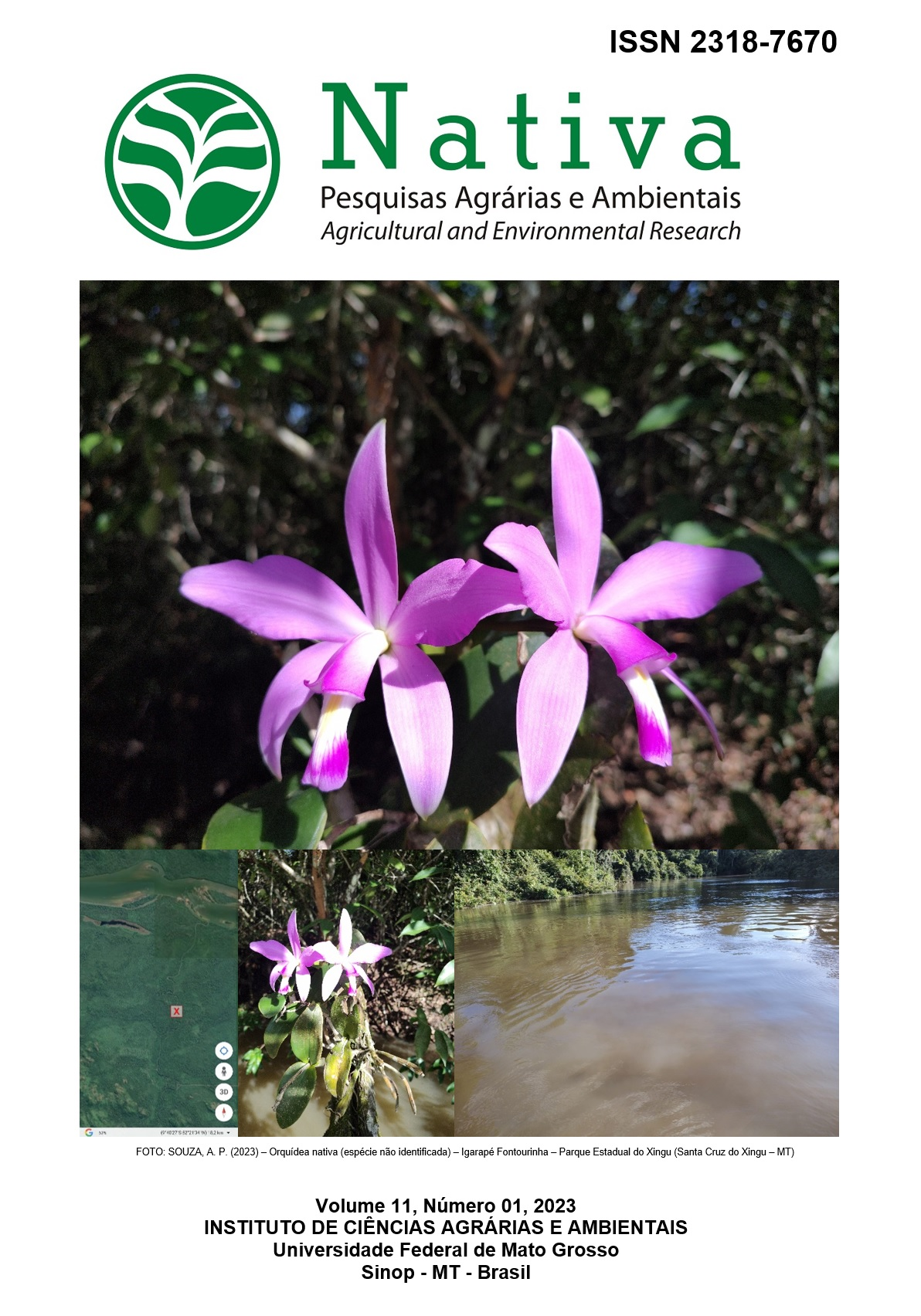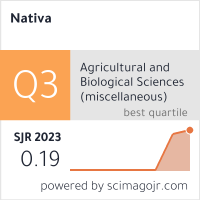BIOLOGICAL CONTROL OF TERMITES: A BIBLIOMETRIC AND STATE-OF-THE-ART REVIEW
DOI:
https://doi.org/10.31413/nativa.v11i1.14852Palavras-chave:
pesticides, Xylophagous agent, control agents, ecosystem engineers, systematic reviewResumo
ABSTRACT: Termites are considered pests and biological control is an environmentally friendly alternative to reduce pesticide contamination. It was aimed with this study to compile the publications indexed in the Scopus platform referring to biological control of termites between 1981 and 2019. A total of 143 publications were found, each of which was read and filtered according to the selection criteria. The studies analyzed were conducted in 16 countries, with the United States leading the way (44%). A total of 55 termite species and seven families were recorded in the papers. For the control agents tested, more than 140 species were identified and classified. Plant insecticides were the most cited, with emphasis on oils and extracts from Azadirachta indica and Chamaecyparis obtusa. It was noted that most research was conducted on a laboratory scale in the form of experimental designs. This may limit more comprehensive discussions of the biological termite control agents tested. Although the use of other control agents is increasing, there is a wide range of insecticides and plant-derived compounds that can be studied.
Keywords: pesticides; Xylophagous agente; control agentes; ccosystem engineers; systematic review.
Controle biológico de cupins: uma revisão bibliométrica e estado da arte
RESUMO: Os cupins são considerados pragas e o controle biológico é uma alternativa ecologicamente correta para reduzir a contaminação por pesticidas. Objetivou-se com este estudo compilar as publicações indexadas na plataforma Scopus referentes ao controle biológico de cupins entre 1981 e 2019. Foram encontradas 143 publicações, cada uma delas foi lida e filtrada de acordo com os critérios de seleção. Os estudos analisados foram realizados em 16 países, com os Estados Unidos liderando (44%). Um total de 55 espécies de cupins e sete famílias foram registradas nos trabalhos. Para os agentes de controle testados, mais de 140 espécies foram identificadas e classificadas. Os inseticidas vegetais foram os mais citados, com ênfase em óleos e extratos das espécies Azadirachta indica e Chamaecyparis obtusa. Foi observado que a maioria das pesquisas foram conduzidas em escala laboratorial na forma de delineamentos experimentais. Isto pode limitar discussões mais aprofundadas sobre os agentes biológicos de controle de cupins testados. Embora o uso de outros agentes de controle esteja aumentando, há uma vasta gama de inseticidas e compostos derivados de plantas que podem ser estudados.
Palavras-chave: pesticidas; agente Xilófago; agentes de controle; engenheiros de ecossistema; revisão sistemática.
Referências
ARAUJO, E. C. G.; SANQUETTA, C. R.; DALLA CORTE, A. P.; PELISSARI, A. L.; ORSO, G. A.; SILVA, T. C. Global review and state-of-the-art of biomass and carbon stock in the Amazon. Journal of Environmental Management, v. 331, e1172512023, 2023. https://doi.org/10.1016/j.jenvman.2023.117251
BATISTA, F. G.; MELO, R. R.; MEDEIROS, D. T.; LOPES, P. J. G.; GATTO, D. A. Natural durability of five tropical wood species in field decay tests. Maderas. Ciencia y Tecnología, v. 24, n. 51, p.1-10, 2022. http://dx.doi.org/10.4067/s0718-221x2022000100451
BAUDOUIN, G.; BECH, N.; BAGNÈRES, A. G.; DEDEINE, F. Spatial and genetic distribution of a north American termite, Reticulitermes flavipes, across the landscape of Paris. Urban Ecosystems, v. 21, n. 4, p. 751-764, 2018. https://doi.org/10.1007/s11252-018-0747-9
BIGNELL, D. E. Termites as soil engineers and soil processors. In: KÖNIG, H.; VARMA, A. (Eds.) Intestinal microorganisms of termites and other invertebrates. Berlin: Springer, 2006, p. 183-220.
BIGNELL, D. E.; ROISIN, Y.; LO, N. Biology of termites: a modern synthesis. Berlin: Springer Science & Business Media, 2014, 576 p.
BOURGUIGNON, T.; LO, N.; ŠOBOTNÍK, J.; SILLAM-DUSSÈS, D.; ROISIN, Y.; EVANS, T. A. Oceanic dispersal, vicariance and human introduction shaped the modern distribution of the termites Reticulitermes, Heterotermes and Coptotermes. Proceedings of the Royal Society B: Biological Sciences, v. 283, n. 1827, e20160179, 2016.
CHOUVENC, T.; SU, N. Y. Apparent synergy among defense mechanisms in subterranean termites (Rhinotermitidae) against epizootic events: Limits and potential for biological control. Journal of Economic Entomology, v. 103, n. 4, p. 1327-1337, 2010. https://doi.org/10.1603/EC09407
CHOUVENC, T.; SU, N. Y.; GRACE, J. K. Fifty years of attempted biological control of termites–Analysis of a failure. Biological Control, v. 59, n. 2, p. 69-82, 2011. https://doi.org/10.1016/j.biocontrol.2011.06.015
CONSTANTINO, R Isoptera. In: CONSTANTINO, R.; RAFAEL, J. A.; MELO, G. A. R.; CARVALHO, C. J. B.; CASARI, S. A. Insetos do Brasil: diversidade e taxonomia, Ribeirão Preto: Holos Editora, 2012, p. 311-322.
CONSTANTINO, R. Termite Database. Disponível em: <http://www.termitologia.net/brasil.html>. Acesso em: 30 dez. 2022.
DONTHU, N.; KUMAR, S.; MUKHERJEE, D.; PANDEY, N.; LIM, W. M. How to conduct a bibliometric analysis: an overview and guidelines. Journal of Business Research, v. 133, p. 285-296, 2021. https://doi.org/10.1016/j.jbusres.2021.04.070
EGGLETON, P. An introduction to termites: biology, taxonomy and functional morphology. In: BIGNELL, D.E.; ROISIN, Y.; LO, N. Biology of termites: a modern synthesis. Berlin: Springer Science & Business Media, 2014. p. 1-26.
ELSEVIER. Scopus: Content coverage guide. 2011, 24p.
ENGEL, M. S. Family-group names for termites (Isoptera), redux. ZooKeys, n. 148, p. 171-184, 2011. https://doi.org/10.3897/zookeys.148.1682
EVANS, T. A. Predicting ecological impacts of invasive termites. Current Opinion in Insect Science, v. 46, p. 88-94, 2021. https://doi.org/10.1016/j.cois.2021.03.003
GHESINI, S.; PILON, N.; MARINI, M. A new finding of Reticulitermes flavipes in northern Italy. Bulletin of Insectology, v. 64, n. 1, p.83-89, 2011.
GUI‐XIANG, L.; ZI‐RONG, D.; BIAO, Y. Introduction to termite research in China. Journal of Applied Entomology, v. 117, n. 1, p. 360-369, 1994. https://doi.org/10.1111/j.1439-0418.1994.tb00747.x
GULLAN, P. J.; CRANSTON, P. S. Insetos: Fundamentos da Entomologia. São Paulo: Guanabara Koogan, 2017. 460 p.
GOVORUSHKO, S. Economic and ecological importance of termites: A global review. Entomological Science, v. 22, p. 21-35, 2019. https://doi.org/10.1111/ens.12328
HÄNEL, H. A bioassay for measuring the virulence of the insect pathogenic fungus Metarhizium anisopliae (Metsch.) Sorok. (fungi imperfecti) against the termite Nasutitermes exitiosus (Hill) (Isoptera, Termitidae). Zeitschrift für Angewandte Entomologie, v. 92, n. 1, p. 9-18, 1981. https://doi.org/10.1111/j.1439-0418.1981.tb01646.x
HASSAN, B.; MANKOWSKI, M. E.; KIRKER, G.; AHMED, S. Effects of heartwood extractives on symbiotic protozoan communities and mortality in two termite species. International Biodeterioration & Biodegradation, v. 123, p. 27-36, 2017. https://doi.org/10.1016/j.ibiod.2017.05.023
HOLT, J. A.; LEPAGE, M. Termites and Soil Properties. In: ABE, T.; BIGNELL D. E.; HIGASHI M. (Eds.) Termites: Evolution, Sociality, Symbioses, Ecology. Dordrecht: Springer, 2000. p. 389-407.
HOTTENROTT, H.; LAWSON, C. Research grants, sources of ideas and the effects on academic research. Economics of Innovation and New Technology, v. 23, n. 2, p. 109-133, 2014. https://doi.org/10.1080/10438599.2013.814425
ISMAN, M. B. Botanical insecticides: a global perspective. In: GROSS, A. D.; COATS, J. R.; DUKE, S. O.; SEIBER, J. N. Biopesticides: State of the Art and Future Opportunities. Oxford: Oxford University Press, 2014. p. 21-30.
KRISHNA, K.; GRIMALDI, D. A.; KRISHNA, V.; ENGEL, M. S. Treatise on the Isoptera of the World: Basal Families. Bulletin of the American Museum of Natural History, v. 2013, n. 377, p. 200-623, 2013. https://doi.org/10.1206/377.1
LENZ, M.; SUNDEN-BYLEHN, A.; THORNE, B. L.; LEWIS, V. R.; HAVERTY, M. Finding alternatives to persistent organic pollutants (POPs) for termite management. UNEP/FAO/Global IPM Facility Expert Group on Termite Biology and Management, United Nations Environment Programme/Food and Agriculture Organization of the United Nations/Global Integrated Pest Management Facility. Rome: United Nations Environment Programme, 2003. 50 p.
LIMA, J. T.; COSTA-LEONARDO, A. M. Recursos alimentares explorados pelos cupins (Insecta: Isoptera). Biota Neotropica, v. 7, n. 2, p. 1-8, 2007. https://doi.org/10.1590/S1676-06032007000200027
LOWE, S.; BROWNE, M.; BOUDJELAS, S.; POORTER, M. 100 of the world's worst invasive alien species: a selection from the global invasive species database. Auckland: Invasive Species Specialist Group. 2000, 11 p.
MASCARENHAS, A. R. P.; MELO, R. R.; PIMENTA, A. S.; STANGERLIN, D. M.; CORRÊA, F. L. O.; SCCOTI, M. S. V.; PAULA, E. A. O. Ultrasound to estimate the physical-mechanical properties of tropical wood species grown in an agroforestry system. Holzforschung, v. 75, p. 879-897, 2021. https://doi.org/10.1515/hf-2020-0249
MEDEIROS, D. T.; MELO, R. R.; CADEMARTORI, P. H. G.; BATISTA, F. G.; MASCARENHAS, A. R. P. Caracterização da madeira de espécies da Amazônia. Madera y Bosques, v. 27, e2722209, 2021. https://doi.org/10.21829/myb.2021.2722209
MEDEIROS NETO, P. N.; PAES, J. B.; GONÇALVES, F. G.; LÓPEZ, Y. M.; BARAÚNA, E. E.; RIBEIRO, L. S. Relation of physicochemical characteristics on biological resistance of eucalypts woods to xylophagous termites. Journal of Building Engineering, v. 52, e104462, 2022. https://doi.org/10.1016/j.jobe.2022.104462
PAUL, B.; SINGH, S.; SHANKARGANESH, K.; KHAN, M.A. Synthetic insecticides: the backbone of termite management. In: KHAN, M. A.; AHMAD, W. Termites and Sustainable Management. Cham: Springer, 2018. p. 233-260.
PRASTYANINGSIH, S.; HARDIWINOTO, S.; KORANTO, C. A. D. Diversity of termites (Isoptera) on industrial forest plantation of Eucalyptus pellita stands of tropical ecosystem in Riau, Indonesia. Biodiversitas, v. 21, n. 11, p. 5498-5505, 2020. https://doi.org/10.13057/biodiv/d211158
SILVA, T. C.; ARAUJO, E. C. G.; LINS, T. R. S.; REIS, C. A.; SANQUETTA, C. R.; ROCHA, M. P. Non-Timber Forest Products in Brazil: A Bibliometric and a State of the Art Review. Sustainability, v. 12, p. 1-17, e7151, 2020. https://doi.org/10.3390/su12177151
Downloads
Publicado
Versões
- 2024-06-11 (2)
- 2023-04-17 (1)
Edição
Seção
Como Citar
Licença
Copyright (c) 2023 Nativa

Este trabalho está licenciado sob uma licença Creative Commons Attribution-NonCommercial 4.0 International License.
Direitos Autorais para artigos publicados nesta revista são do autor, com direitos de primeira publicação para a revista. Em virtude de a aparecerem nesta revista de acesso público, os artigos são de uso gratuito, com atribuições próprias, em aplicações educacionais e não-comerciais.
A artigos publicados nessa revista, podem ser reproduzidos parcialmente ou utilizados como referência por outros autores, desde que seja cita a fonte, ou seja, a Revista Nativa.
Copyright for articles published in this journal are the authors, with first publication rights granted to the journal. The journal shows open access, and articles are free to use, with proper attribution, in educational and non-commercial.
The articles published in this journal may be reproduced in part or used as a reference by other authors, provided that the source is quoted.






